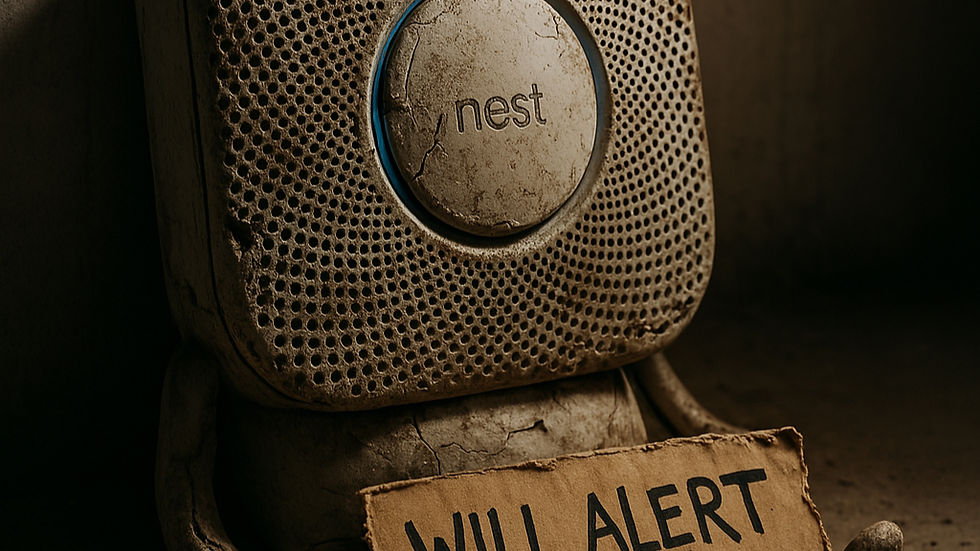Google's Decision to Discontinue Nest Protect and What It Means for Smart Homes
- team63418
- Mar 27
- 3 min read
Updated: Jun 18

Overview of Nest Protect Discontinuation
After over a decade of service, Google has announced the discontinuation of its smoke and carbon monoxide alarm, Nest Protect. Existing units will still function and receive support until their designated expiration dates. However, no new devices will be produced. This decision marks the end of the Nest Protect product line.
Google's choice aligns with its strategy to create a more versatile and innovative smart home environment. By collaborating with third-party manufacturers, such as First Alert, Google aims to enhance device compatibility and functionality. The company is moving away from a proprietary ecosystem toward one that embraces open standards and interoperability.
Introduction of First Alert Smart Smoke & Carbon Monoxide Alarm
As a direct replacement for the Nest Protect, First Alert has introduced a new smart smoke and carbon monoxide alarm. This device is designed to integrate seamlessly with the Google Home ecosystem. It offers several enhancements that may appeal to users:
Integration with Google Home and First Alert Apps: Users can receive alerts and control the alarm through familiar interfaces. This makes managing home safety more convenient.
Interconnectivity with Existing Nest Protect Alarms: The alarm utilizes Google's Weave communication protocol. This ensures synchronization with current Nest Protect units, allowing for cohesive operation throughout the home.
User-Friendly Features: The device includes automatic safety checkups, early warning alerts, and the ability to silence alarms via the associated apps.
Limitations of the New Alarm
While the First Alert alarm brings many advantages, it is essential to note some limitations. It lacks certain features present in the Nest Protect, such as the innovative presence sensor and nightlight. Furthermore, it does not support the new Matter smart home standard, which may impact future interoperability with other devices. Users should weigh these factors carefully.
Benefits of Open Ecosystems
Transitioning to an open ecosystem offers several advantages for consumers, which are vital to understand:
Increased Device Compatibility: An open ecosystem facilitates integration with various smart home products. This flexibility allows users to create a more customized setup tailored to their needs.
Enhanced Innovation: Open standards encourage third-party manufacturers to introduce new features and improvements. This drive for innovation results in advancements throughout the smart home technology landscape.
Future-Proofing: By prioritizing open standards, devices are better positioned to remain compatible with emerging technologies. This approach protects consumers' investments in their smart home infrastructure.
The Importance of Smart Home Safety
In today’s world, smart home safety is more critical than ever. Devices like smoke and carbon monoxide alarms play a crucial role in protecting families and households. As technology advances, integrating safety features with smart home systems increases peace of mind for users. The shift from proprietary devices to open ecosystems supports this functionality, allowing for innovative safety solutions.
Considerations for Current Nest Protect Users
For those who currently own Nest Protect devices, it’s crucial to be aware of the impending changes. Google has assured users that they will continue to receive support and functionality through their products' intended lifespan. However, users should keep track of their device's expiration date and begin planning for its eventual replacement.
Assessing Your Smart Home Needs
As Google transitions away from Nest Protect, consumers should carefully assess their specific needs and how new devices fit within their current smart home setups. The new First Alert Smart Smoke & Carbon Monoxide Alarm provides an alternative worth considering, especially for those invested in the Google Home ecosystem.
The Future of Smart Home Technology
Google's decision to discontinue the Nest Protect represents a strategic shift towards an open and collaborative smart home ecosystem. While this transition introduces new alternatives like the First Alert Smart Smoke & Carbon Monoxide Alarm, it is essential to understand that embracing open ecosystems promises enhanced flexibility and innovation. This shift paves the way for a more integrated and user-centric smart home experience.
In conclusion, users must stay informed about changes in smart home technology and make choices that best suit their needs. The opportunities presented by new devices, such as the First Alert alarm, highlight the potential for growth in smart home safety and functionality. Continued advancements will likely lead to even more efficient and user-friendly products, enhancing lives for homeowners everywhere.

Comments